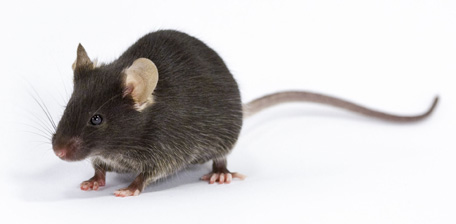Description
 The C57BL/6J-Min strain is a congenic derivative of C57BL/6J that is highly susceptible to spontaneous intestinal adenoma formation. Min (multiple intestinal neoplasia) is an autosomal dominant trait and involves a nonsense mutation in codon 850 of the murine Apc gene. The Apc gene is the homolog of human APC (adenomatous polyposis coli) gene (1). C57BL/6J-Min/Min (homozygous) mice are not viable. One hundred percent (100%) of the C57BL/6J-Min/+ (heterozygous) mice raised on a high fat diet develop in excess of 30 adenomas throughout the intestinal tract and most die by 120 days of age (2). A small number of C57BL/6J-Min/+ female mice develop mammary tumors (3).
The C57BL/6J-Min strain is a congenic derivative of C57BL/6J that is highly susceptible to spontaneous intestinal adenoma formation. Min (multiple intestinal neoplasia) is an autosomal dominant trait and involves a nonsense mutation in codon 850 of the murine Apc gene. The Apc gene is the homolog of human APC (adenomatous polyposis coli) gene (1). C57BL/6J-Min/Min (homozygous) mice are not viable. One hundred percent (100%) of the C57BL/6J-Min/+ (heterozygous) mice raised on a high fat diet develop in excess of 30 adenomas throughout the intestinal tract and most die by 120 days of age (2). A small number of C57BL/6J-Min/+ female mice develop mammary tumors (3).
Background
Genetic background of Min/+ mice affects tumor number and progression as well as lifespan. For example, (AKR/J x C57BL/6J-Min/+)F1 mice develop an average of five tumors per mouse and can live beyond 300 days (4). On resistant hybrid backgrounds, mammary adenocarcinomas and adenocanthomas are found in association with the Min allele in approximately 10% of the longer-lived female Min/+ mice (3).
Min/Min (homozygous) mice are not viable on any of the genetic backgrounds studied to date. The number of tumors and lifespan of Min/+ mice are affected by alleles at modifier loci that are not linked to Min. One such dominant modifier locus, designated Mom-1 (Modifier-of-Min), has been mapped (5).
The C57BL/6J-Min/+ mouse presents an opportunity to study pathogenesis of a neoplasia in which the initial molecular defect is the same between human and mouse. The response of the Min phenotype to modifier loci offers the opportunity to scan the murine genome for factors that suppress or enhance the intestinal or mammary neoplasia observed in Min/+ mice.
Discovery and development
The Min mutation was discovered in the progeny of a C57BL/6J male who was mutagenized by ethylnitrosourea. The founding (AKR x C57BL/6J)F1 female mouse displayed circling behavior and was backcrossed to C57BL/6J. Some progeny of this backcross mating developed anemia as adults. The anemia was related to development of intestinal adenomas, and proved to be inherited as an autosomal dominant trait. Backcrosses to C57BL/6J were continued to create the C57BL/6J-Min strain.
Breeding
The Min mutation is maintained by mating C57BL/6J-+/+ female mice to C57BL/6J-Min/+ male mice. The Min mutation cannot be efficiently propagated through the female because anemia and intestinal adenomas interfere with pregnancy. The breeding performance of the C57BL/6J-Min/+ male declines as anemia and intestinal tumor develop. To maximize the reproductive potential of C57BL/6J-Min/+ male mice, one or two female mice are placed with a C57BL/6J-Min/+ male. The female mice are replaced weekly with other female mice. C57BL/6 male mice have low androgen levels (6,7) and usually mate only once or twice a week. Placing more than two female mice at a time with a C57BL/6 male can be counterproductive.
Genotyping
Min/+ mice can be detected using a PCR (polymerase chain reaction) method to detect the single base pair substitution in the mutant allele. DNA is prepared from blood collected from the retro-orbital sinus.
Tumor scoring
Intestinal tumor counts are obtained by counting 4 cm of the duodenum, 4 cm of jejunum, 4 cm of distal ileum and the entire large intestine. The intestine is first cut into lengths. Each piece is opened longitudinally with micro dissecting scissors. The mucosal surface is rinsed free of intestinal contents and mucus using phosphate buffered saline, and then spread flat, mucosal surface up, on bibulous paper. Tumors as small as 0.5 mm are observed using a dissecting microscope with 10X magnification.
Mammary tumors are detected by palpation or visual observation. They usually grow quite rapidly and become locally invasive. The mice should be monitored at least weekly.
References
1. Su L-K, Kinzler KW, Vogelstein B, Preisinger AC, Moser AR, Luongo A, Gould KA, and Dove WF. A germline mutation of the murine homolog of the APC gene causes multiple intestinal neoplasia. Science, 1992. 256:668-670.
2. Moser AR, Pitot HC, and Dove WF. A dominant mutation that predisposes to multiple intestinal neoplasia in the mouse. Science, 1990. 247:322-324.
3. Moser AR, Mattes E, Dove WF, Lindstrom M, Haag J, and Gould M. Proc Natl Acad Sci USA, in press, 1993.
4. Moser AR, Dove WF, Roth KA, and Gordon JI. The Min (multiple intestinal neoplasia) mutation: Its effects on gut epithelial cell differentiation and interaction with a modifier system. J Cell Biol, 1992. 116:1517-1526.
5. Dietrich W, Lander E (The Whitehead Institute), Moser AR, Gould K, Luongo C, Borenstein N, and Dove WF (The McArdle Laboratory). In preparation.
6. McGill TE. An enlarged study of genotype and recovery of sex drive in male mice. Psychon Sci, 1969. 15:250-251.
7. Bartke A, Shire JGM. Differences between mouse strains in testicular cholesterol levels and androgen target cells. J Endocrinol. 55:173-184.